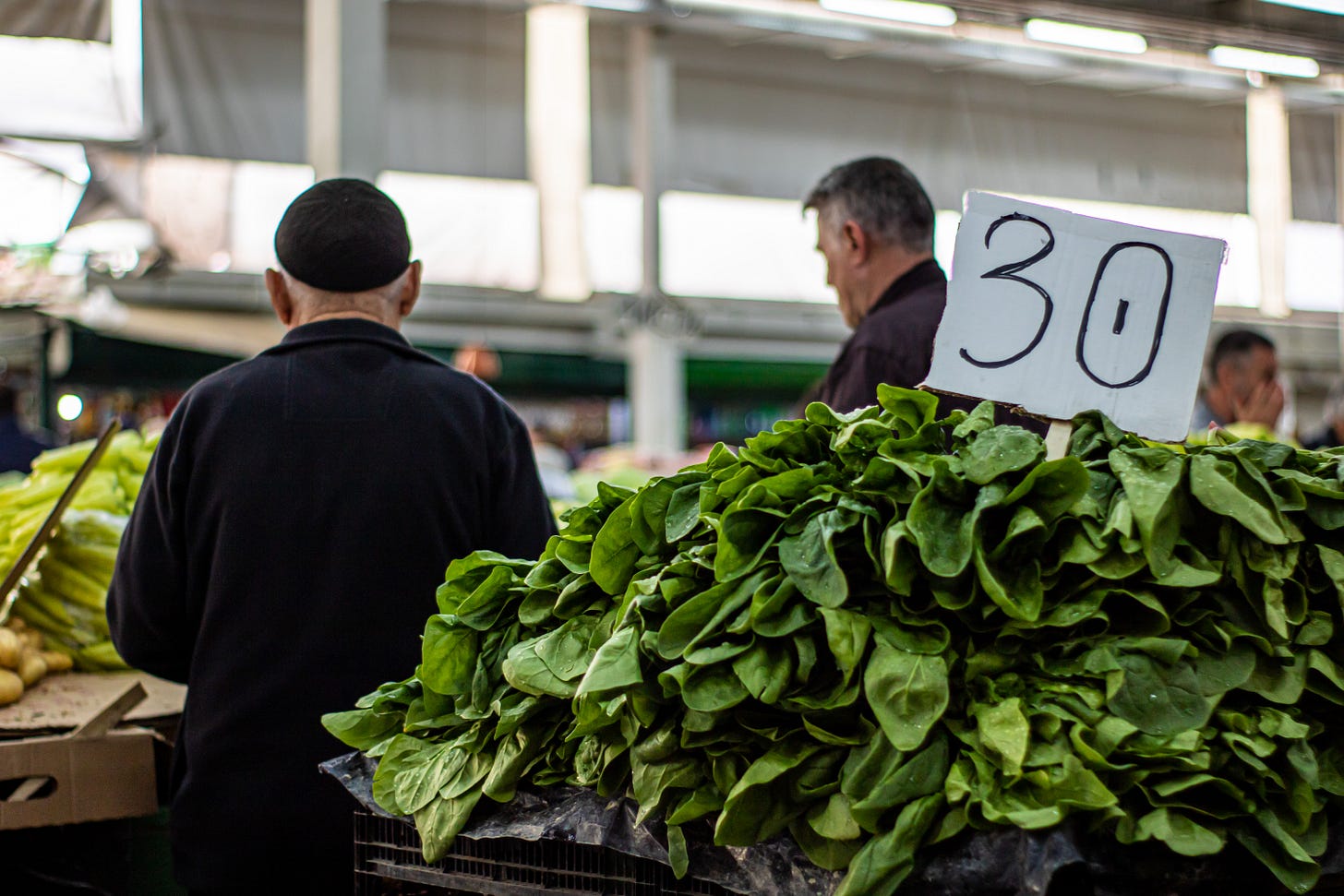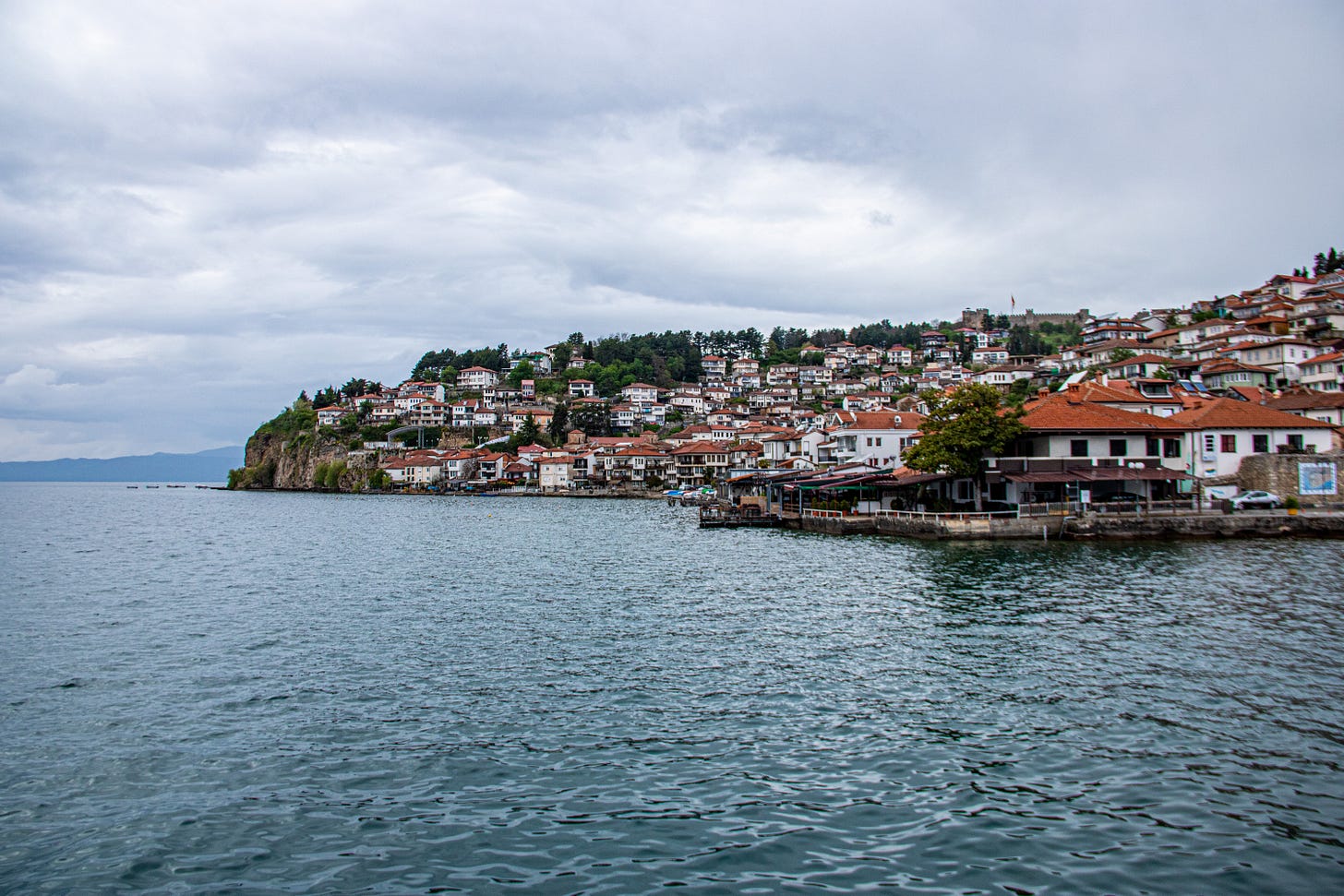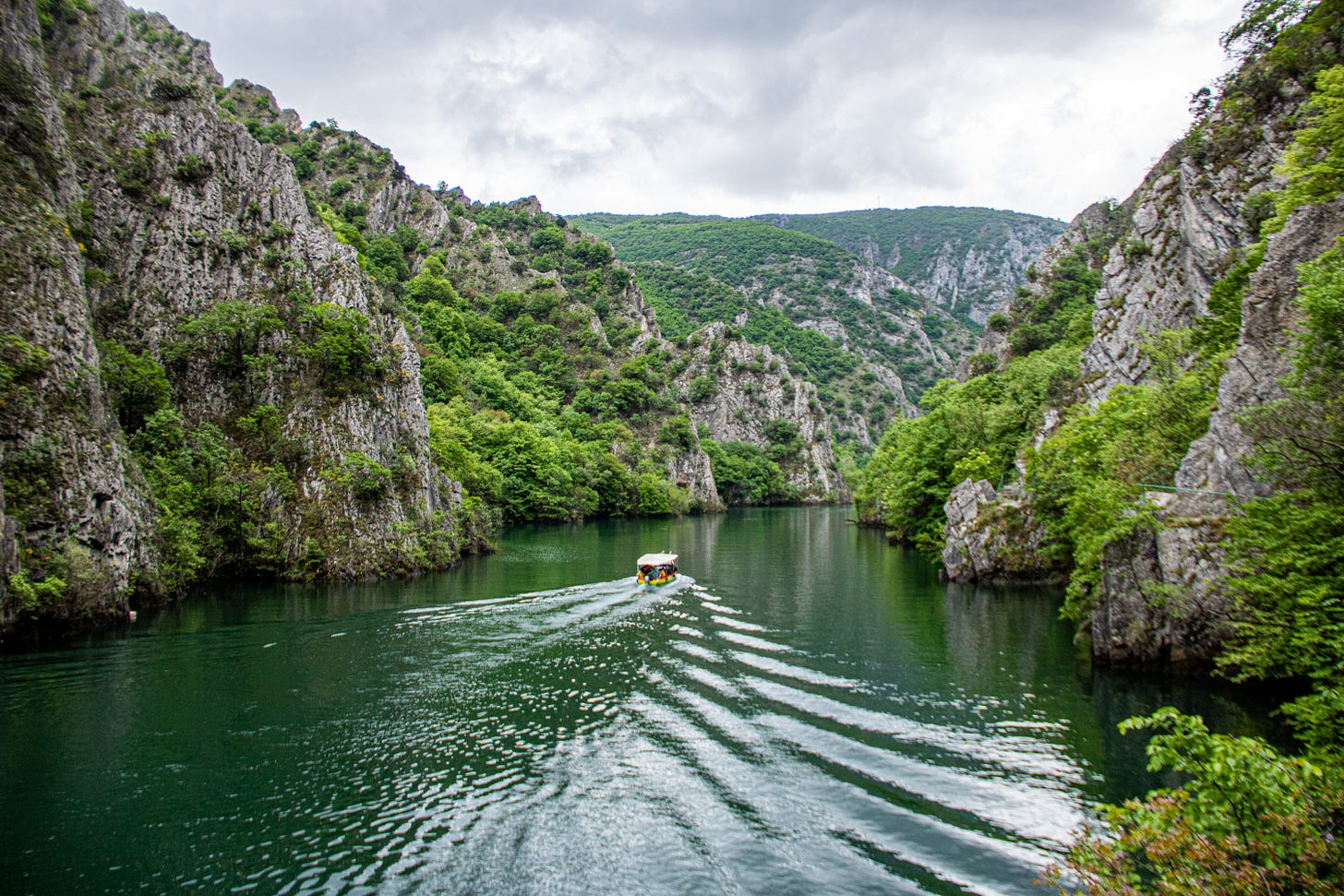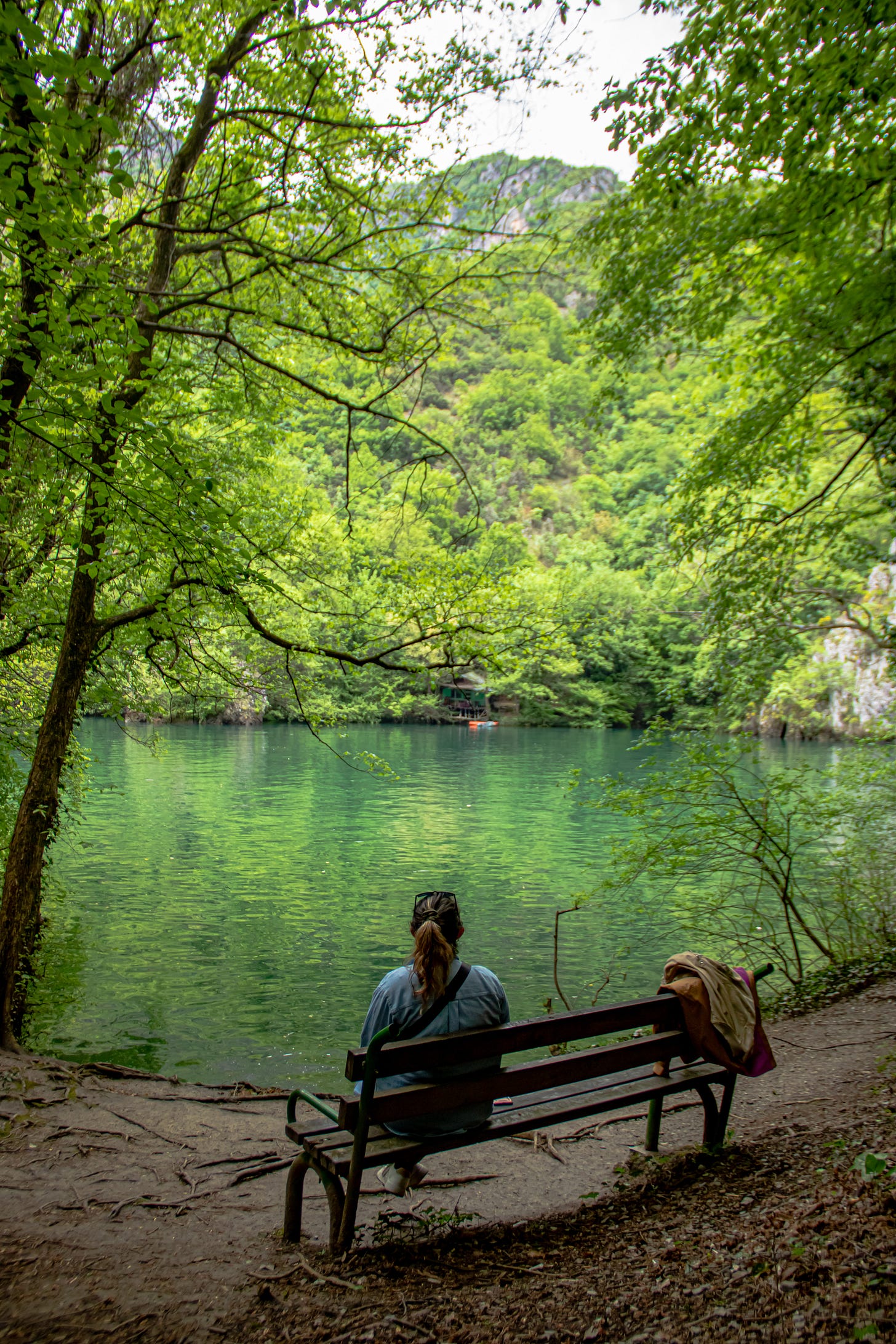Things to do in North Macedonia
Four days in the Balkans, Skopje, Ohrid lake and Matka canyon.
After being in Belgrade in February 2023 I wanted to continue the exploration of the Balkans and in May of the same year, I decided to visit North Macedonia. To be honest with my girlfriend we decided to go there just because the flight was cheap, we were open to going everywhere around Europe but on a budget and in the end it was the best option. North Macedonia is a country located in the Balkan Peninsula in Southeast Europe, the border counties are Albania, Kosovo, Serbia, Bulgaria and Greece, we spent four days visiting the capital Skopje, lake Ohrid and Matka Canyon.
Skopje
Skopje is situated in the north-central part of North Macedonia, on the banks of the Vardar River. Scenic mountains, including Mount Vodno to the southwest, surround it. It has a population of around 550,000, making it the most populous city in North Macedonia. Even if it is the largest city in the country, Skopje is quite small and fast to visit, one day is more than enough, we spent the arrival day and the first day of the trip visiting it.
Skopje has a rich and diverse history that dates back over 2,000 years. Various civilizations, including the Romans, Byzantines, Ottomans, and Yugoslavs have influenced it. It is visible from its multicultural and multiethnic character, and it is home to a blend of different cultures and religions, including Macedonian, Albanian, Turkish, Roma, and others.
What impressed us was the crazy amount of statues that the city has, and this is because of the "Skopje 2014 Urban Renewal Project". This project was initiated in 2010 to transform the city's appearance and reidentify its cultural identity. The project encompassed the construction of numerous statues, monuments, buildings, and renovations throughout the city. I’m not sure it worked well, the number of statues is too much, and there are no criteria behind it, plus the city is an incoherent mix of modernity with a lot of led lights, monuments that recall the communist period, old historic buildings and abandoned ones. I don’t know if this can be the identity of the city and be also an attraction for tourists.
Another impression that we had is that there is not much to do at night, there are not many pubs or bars, only restaurants and more or less the same type of it.
On the day of our arrival, we walked around seeing the main landmarks of the city. The cityscape is dominated by the Vardar River, with the famous Stone Bridge connecting the old and new parts of the city. The main square, Macedonia Square, is adorned with prominent statues, including the iconic Warrior on a Horse, but it is surrounded by abandoned buildings and new ones in construction. Located on the city's highest point, Skopje Fortress (Kale) offers panoramic views of Skopje. The fortress has a long history and has been rebuilt and expanded. It is a popular spot for locals and visitors to enjoy the scenery and learn about the city's past.
The Old Bazaar (Stara Čaršija) is a historic neighbourhood in Skopje. It is one of the largest and best-preserved Ottoman-era marketplaces in the Balkans. Here, you can explore narrow streets lined with shops, cafes, mosques, and historical buildings. Walking through the Old Bazaar is like stepping back in time. The cobbled streets are lined with a wide array of shops, boutiques, and traditional crafts workshops. Here, you can find a range of products, including handmade textiles, copperware, jewellery, spices, traditional clothing, and souvenirs.
We spend here a big part of the first day, and I can say that it is my favourite part of the city, I have to say that I love markets and bazaars. I was expecting something similar to the bazaar in Istanbul, but it is another thing, it is open air and it looks like more of a city district than a market. I liked the atmosphere of it, traditional restaurants, cafes, and teahouses, you can savour authentic Macedonian and Ottoman cuisine, including delicious kebabs, stuffed peppers, börek (savoury pastry), and Turkish coffee. We had our first dinner there and it was delicious, for sure this part of the city is coherent, contrary to the rest of the city.
Lake Ohrid
On the second day, we decided to go outside of the capital and visit Lake Ohrid. This lake is located on the border between North Macedonia and Albania. It is one of the oldest and deepest lakes in Europe, known for its exceptional natural beauty, rich cultural heritage, and diverse ecosystem. From Skopje, there are regular buses that go to Ohrid from the central station, it is also possible to rent a private taxi, but we preferred the cheap option, it was very easy to get the information, we had just to go to the central station and ask at the ticket office. We took the first bus of the day at 8 am and we came back with the last one at 7:30 pm, the bus ride was around 3 hours and a half.
Lake Ohrid is situated in the southwestern part of North Macedonia and extends into Albania. It covers an area of approximately 360 square kilometres, with two-thirds of the lake belonging to North Macedonia and one-third to Albania. It is a UNESCO World Heritage site and has been recognized for its outstanding universal value. It is often referred to as the "Macedonian Pearl" due to its exceptional geological and biological significance. The town of Ohrid, located on the eastern shore of the lake, is a UNESCO World Heritage site in its own right. It is a historic and cultural hub, boasting ancient churches, monasteries, and archaeological sites. The city's Old Town is a maze of narrow cobblestone streets lined with traditional houses and picturesque views of the lake.
A thing that we discovered on the spot is that Lake Ohrid is famous for its pearls they are created by a unique combination of environmental factors: the pearls are formed when a foreign substance, such as a grain of sand or a small parasite, enters the shell of the endemic Ohrid trout, a fish species found in the lake. In response, the trout secretes layers of nacre (mother-of-pearl) around the foreign object, gradually forming a pearl. Lake Ohrid pearls are considered rare and highly prized due to their limited availability.
Honestly, I didn’t know exactly where I was going, they just told us to go there and we were surprised at how beautiful it is, the lake and the village. The village reminds me of villages that you can find also in Italy, with small streets perched on a cliff. In the village, there are several Orthodox churches, the most iconic is the church of Saint John the Theologian, which is on a cliff directly on the lake and offers a beautiful view and opportunities for nice pictures.
We just randomly walked around the village, and the only place we looked for was Saint John's church, we found a nice path on the lake and we got lost on the small streets, it was a lovely surprise to discover Ohrid.
The lake is renowned for its crystal-clear waters, with visibility reaching up to 22 meters. The clarity of the water is attributed to the lake's unique hydrological conditions, including underground springs and the lack of major tributaries. Lake Ohrid is a treasure trove of biodiversity. It is home to more than 200 species of plants and over 1,200 animal species, many of which are endemic and found nowhere else in the world. The lake's ecosystem is considered one of the most diverse and well-preserved in Europe.
Even if we were there in May the weather was cold and there were no conditions to enjoy the lake, but Lake Ohrid offers several sandy and pebble beaches along its shores, providing opportunities for swimming, sunbathing, and water sports. Popular activities include sailing, fishing, kayaking, and scuba diving.
Matka Valley
On the third day we went to the Matka Valley which is a picturesque natural area located just outside Skopje, it is known for its stunning canyon, pristine lake, and rich biodiversity. The canyon is very close to the city, it is easy to reach by bus 60 from the central station, it is also possible to buy an organized trip that can show you also Mount Vodno or rent a taxi. Of course, we used the cheapest option and we went by bus in less than an hour, but to come back we had a problem, the bus doesn’t start from the last stop near the canyon but from the one before so we lost the bus and the one after it was very late, so with another traveller we shared a taxi. To understand exactly where to find bus 60, how to buy the ticket and the timeline you can download the app Skopska.
The main attraction of Matka Valley is its impressive canyon carved by the Treska River. The canyon stretches over 5 kilometres and features towering cliffs, fascinating rock formations, and tranquil waters. It offers breathtaking views and is a paradise for nature enthusiasts and photographers. Within the canyon, you'll find Matka Lake, an artificial lake formed by the construction of a dam on the Treska River. The lake is surrounded by sheer cliffs and lush greenery. It is a popular spot for boating, kayaking, and fishing.
There you can do different things, have a boat trip or kayak on the lake, have a trail or simply sit down at the restaurant. We did a trail that took us through scenic landscapes, dense forests, and hidden waterfalls.
One of the key highlights of Matka Valley is Vrelo Cave, also known as the "Profound Cave". It is one of the deepest underwater caves in the world, with a depth of around 212 meters. Visitors can take a boat ride to explore the cave, marvelling at its unique stalactite and stalagmite formations. The cave can be vised only by boat ride, we prefer to have a trail so we didn’t see the cave.
The Matka region is also rich in historical and cultural heritage. There are several medieval monasteries scattered around the valley, including the St. Andrew Monastery and the Matka Monastery, which are worth a visit for their architectural and spiritual significance.
Besides hiking and boating, Matka Valley offers various outdoor activities. Rock climbing enthusiasts can enjoy climbing the cliffs that surround the canyon. Additionally, the crystal-clear waters of Matka Lake provide opportunities for swimming and diving, even if it was May the weather was not the best for these activities, probably the best season is June.
Matka Valley is known for its diverse ecosystem and wildlife. The region is home to numerous plant and animal species, including rare and endemic ones. The area is protected as a nature reserve and is part of the wider Matka Canyon-Matka Lake protected area.
Overall I liked North Macedonia, Matka canyon and Lake Ohrid was the best part of it and they are a must to see, Skopje didn’t impress me, it is not a beautiful city at all, but some parts of it are interesting for me, I like ruins and urbex scenarios. In general, I suggest not spending much time there, but it can be the place to stay and do day trips to visit the beautiful nature of the country and maybe also to the very close Kosovo.



































North Macedonia is a wonderful country and particularly for photography. Skopje, on my first visit, didn’t impress me too much but - by the second - I loved the kitschiness of the statues etc. There’s more to do than meets the eye, but you need a bit of time to explore. There are wonderful art galleries in old hammams, caravanserais, Brutalist buildings, museums. I’m looking forward to my next trip to the country and, like you, might visit the many places I’ve not yet been to in Kosovo as an addition.
I absolutely loved North Macedonia; I spent two weeks in Ohrid and did a road trip to Mavrovo National Park and Skopje. Really an underrated area, thanks for shedding more light on the country!